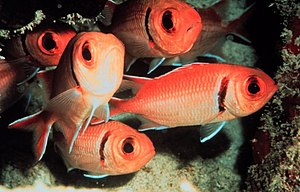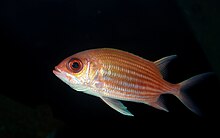Soldier and hussar fish
| Soldier and hussar fish | ||||||||||||
|---|---|---|---|---|---|---|---|---|---|---|---|---|

Caribbean collar soldierfish |
||||||||||||
| Systematics | ||||||||||||
|
||||||||||||
| Scientific name of the order | ||||||||||||
| Holocentriformes | ||||||||||||
| Betancur-R. et al. , 2013 | ||||||||||||
| Scientific name of the family | ||||||||||||
| Holocentridae | ||||||||||||
| Bonaparte , 1832 |
The family of soldier fish and hussar fish (Holocentridae) occurs in the tropical Atlantic , Indian and Pacific Oceans .
features
Soldier and hussar fish are 12 to 61 centimeters long, depending on the species. Your body is flattened on the sides and moderately elongated. They are mostly reddish or pink-colored big-eyed fish with large, clearly visible and very rough comb scales and a forked caudal fin. The scale centers are often lighter, sometimes also silvery or white, and together form a light longitudinal band. The sides of the head are also scaly. On the top of the head there are large mucous channels that can perceive flow stimuli similar to the sideline . The edge of the gill cover is sawn or has spines. The gill spine of some Indo-Pacific species of the genus Sargocentron is poisonous. The mouth is at the end and is inclined upwards, the maxillary is very large and often reaches behind the middle of the eye, the premaxillary is protractile (can be pushed forward). Further jawbones are two supramaxillaries. The lower jaw protrudes. The teeth are small, narrow and stand in rows in the mouth, on the ploughshare bone ( vomer), the gum bone (palatinum), in some species also on the outer wing bone (ectopterygoid).
The large swim bladder can be in contact with the skull. The number of pyloric tubes is eight to 25, that of the Branchiostegaljays eight. The sideline is complete and is accompanied by 25 to 57 pored scales.
The long dorsal fin consists of two parts that are completely or separated by a deep incision. The prickly part, which is twice to four times as long as the soft-rayed part, can be put back in a scaly pit. The dorsal fin is supported by 10 to 12, rarely up to 13 hard rays and 11 to 17 soft rays. One of the hard rays is located in the second, otherwise soft-rayed part of the dorsal fin. The anal fin has four spines, the third is the strongest and longest, and 7 to 16, usually 8 to 13 soft rays. The pelvic fins have a fin spine and five to eight (mostly seven) soft rays. The caudal peduncle is slender, the caudal fin is forked and supported by 18 to 19 fin rays. The fins can be patterned white or yellow. Black markings can also be present, as well as on the gill covers.
Way of life
Soldier and hussar fish live in schools, in pairs or individually, from the water surface to a depth of 100 meters, the species of the genus Ostichthys to a depth of over 200 meters. During the day, the animals live together with cardinalfish , large eye bass and glass or hatchet fish in caves, crevices or under overhangs in rocky and coral reefs of the Atlantic and Indo-Pacific . In the twilight and at night they look for food. They mainly feed on crustaceans , which they ingest from the seabed or in open water.
Reproduction
|
Phylogenetic position of soldier fish and hussar fish
|
Soldier and hussar fish spawn in open water at night or at dusk, making grunting noises with the help of their swim bladders. During the spawning process, they rise to the surface of the water in circles and separate after spawning and a flap of the caudal fin. The eggs contain oil droplets, are 2 to 3 mm in diameter and float on the surface. The larvae are pelagic , elongated in shape and silvery in color. They have long spikes on their heads. The larval form is called the Rhynichthys stage. At a size of 3 cm, they move on to the hidden life of the adult animals.
External system
The soldier and hussar fish were until recently placed in the order of the mucous head-like (Beryciformes), but are the sister group of the perch relatives (Percomorphaceae) and are therefore assigned to a separate subdivision in the latest revision of the bony fish classification, the Holocentrimorphaceae.
Internal system

The Holocentridae consist of two subfamilies. There are about 80 species in eight genera .
- Subfamily Hussarfish (Holocentrinae)
- Subfamily soldier fish (Myripristinae)
Fossil record
The Holocentridae are an old family of fish, with Alloberyx , Caproberyx , Ctenocephalichthys , Paracentrus , Paraspinus , Stichoberyx and Trachichthyoides already from the Cretaceous and with Africentrum , Berybolcensis , Eholocentrum , Holocentrites and Tenuicentrum from the tertiary fossil . Fossils of the recent genera Holocentrus , Myripristus and Sargocentron come from the middle Eocene from Monte Bolca near the Italian city of Verona .
swell
literature
- Joseph S. Nelson : Fishes of the World . John Wiley & Sons, 2006, ISBN 0-471-25031-7
- Kurt Fiedler: Textbook of Special Zoology, Volume II, Part 2: Fish . Gustav Fischer Verlag Jena, 1991, ISBN 3-334-00339-6
- DW Greenfield: Holocentridae Squirrelfishes (soldierfishes). Page 1192 in FAO Species Identification guide for Fishery Purposes: The Living Marine Resources of the Western Central Atlantic, Volume 2 Bony fishes part 1 (Acipenseridae to Grammatidae) , ISSN 1020-6868
- Robert Patzner, Horst Moosleitner: Sea water atlas . 6th volume. 1st edition. Mergus Verlag., Melle 1999, ISBN 3-88244-116-X .
- Alex Dornburga, Jon A. Moore, Rachel Webster, Dan L. Warren, Matthew C. Brandley, Teresa L. Iglesias, Peter C. Wainwright, Thomas J. Near: Molecular phylogenetics of squirrelfishes and soldierfishes (Teleostei: Beryciformes: Holocentridae): Reconciling more than 100 years of taxonomic confusion. Molecular Phylogenetics and Evolution, Volume 65, Issue 2, November 2012, Pages 727-738, doi: 10.1016 / j.ympev.2012.07.020
Individual evidence
-
↑ a b Ricardo Betancur-R., Richard E. Broughton, Edward O. Wiley, Kent Carpenter, J. Andrés López, Chenhong Li, Nancy I. Holcroft, Dahiana Arcila, Millicent Sanciangco, James C Cureton II, Feifei Zhang, Thaddaeus Buser, Matthew A. Campbell, Jesus A Ballesteros, Adela Roa-Varon, Stuart Willis, W. Calvin Borden, Thaine Rowley, Paulette C. Reneau, Daniel J. Hough, Guoqing Lu, Terry Grande, Gloria Arratia, Guillermo Ortí: The Tree of Life and a New Classification of Bony Fishes. PLOS Currents Tree of Life. 2013 Apr 18 [last modified: 2013 Apr 23]. Edition 1. doi: 10.1371 / currents.tol.53ba26640df0ccaee75bb165c8c26288 , PDF ( Memento of the original from October 13, 2013 in the Internet Archive ) Info: The archive link was inserted automatically and has not yet been checked. Please check the original and archive link according to the instructions and then remove this notice. R. Betancur-R., E. Wiley, N. Bailly, A. Acero, M. Miya, G. Lecointre, G. Ortí: Phylogenetic Classification of Bony Fishes - Version 4 (2016)
- ^ Karl Albert Frickhinger: Fossil Atlas Fish , Mergus-Verlag, Melle, 1999, ISBN 3-88244-018-X
Web links
- Soldier and hussar fish on Fishbase.org (English)
